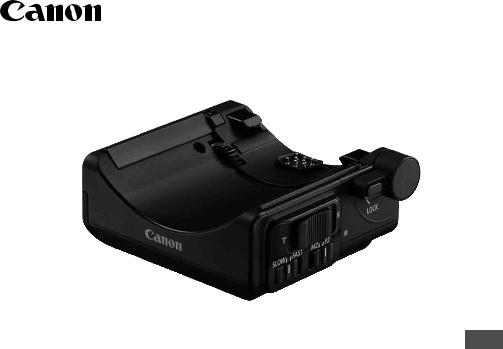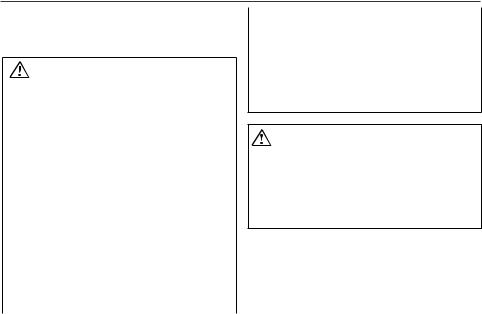Canon PZ-E1 Manual

POWER ZOOMADAPTER PZ-E1
ENG
Instructions

Thank you for purchasing a Canon product.
The Canon POWER ZOOM ADAPTER PZ-E1 is an accessory that allows powered zooming when attached to a lens for EOS cameras*.
Before use, please read this instruction manual as well as the instruction manual for your camera and lens. There may be warnings regarding shooting listed in them.
*Supported lens for EOS cameras (as of February 2016):
EF-S18-135mm f/3.5-5.6 IS USM
Conventions used in this instruction
Warning to prevent adapter, lens, or camera malfunction or damage.
Supplementary notes on using the adapter.
ENG-1

 Safety Precautions
Safety Precautions
Precautions to ensure that the camera is used safely. Read these precautions thoroughly. Make sure all details are observed in order to prevent risks and injury to the user and other people.
Warning |
Details pertaining to risks that may |
result in death or serious injury. |
●Care must be taken with the batteries used in the product, as follows. They may produce heat, smoke, flame, or leak or burst, causing fires or injuries.
•Do not use batteries with a nominal voltage in excess of 1.5 V or where the nominal voltage cannot be confirmed.
•Do not mix battery brands or use old and new batteries together.
•Make sure you put the batteries in the right way around.
•Do not disassemble batteries, recharge them (unless rechargeable), leave them in hot places, apply heat to them, short out their terminals, or throw them in a fire.
●When using some brands of AAA lithium batteries, there may be rare cases when the battery gets extremely hot. For safety's sake, please do not use AAA lithium batteries.
●Do not allow the product to maintain contact with the same area of skin for extended periods of time during use. This may result in low-temperature contact burns, including skin redness and blistering, even if the product does not feel hot. The use of a tripod or similar equipment is recommended when using the product in hot places and for people with circulation problems or less sensitive skin.
Caution |
Details pertaining to risks that |
may result in injury. |
●There is the risk of getting your finger or hair caught between the lens zoom ring and the product. Take care when using the product.
●If internal fluid such as battery leaks get on you, wash it off thoroughly with water. Do not rub your eyes or mouth while you have fluid on your hands.
ENG-2

Safety Precautions
Caution |
Details pertaining to risks that may |
result in damage to property. |
●This is a precision instrument. Do not drop it, subject it to shock, or attempt to dismantle it yourself.
●When carrying a lens or a camera to which the adapter is attached, always carry it by the lens/ camera body.
●Do not leave the adapter in excessive heat such as in a car in direct sunlight. High temperatures can cause the adapter to malfunction.
●Remove the battery when you are not using the adapter. Fluid leakage can cause the adapter to malfunction.
 General Precautions
General Precautions
Handling Precautions
●If the adapter is taken from a cold environment into a warm one, condensation may develop on the outside surface and internal parts. To prevent condensation in this case, first put the adapter into an airtight plastic bag before taking it from a cold to warm environment. Then take out the adapter after it has warmed gradually. Do the same when taking the adapter from a warm environment into a cold one.
Shooting Precautions
●When using the power zoom, the lens will stop before the limit at both the wide and telephoto ends. The available focal length range is limited. The focal length range where the power zoom can be used differs for each lens. Refer to “Materials” on Page 10 for details.
●Attaching the camera to a tripod may cause interference with the adapter. If this is the case, please use the separately-sold TS-E Lens Tripod Adapter.
ENG-3

This device complies with Part 15 of the FCC Rules. |
CAN ICES-3 (B) / NMB-3 (B) |
Operation is subject to the following two conditions: (1) This |
|
|
|
device may not cause harmful interference, and (2) this |
|
device must accept any interference received, including |
|
interference that may cause undesired operation. |
|
Do not make any changes or modifications to the equipment |
|
unless otherwise specified in the instructions. If such |
|
changes or modifications should be made, you could be |
|
required to stop operation of the equipment. |
|
This equipment has been tested and found to comply with |
|
the limits for a class B digital device, pursuant to part 15 |
|
of the FCC Rules. These limits are designed to provide |
|
reasonable protection against harmful interference in a |
|
residential installation. This equipment generates, uses and |
|
can radiate radio frequency energy and, if not installed and |
|
used in accordance with the instructions, may cause harmful |
|
interference to radio communications. |
|
However, there is no guarantee that interference will not |
|
occur in a particular installation. If this equipment does |
|
cause harmful interference to radio or television reception, |
|
which can be determined by turning the equipment off and |
|
on, the user is encouraged to try to correct the interference |
|
by one or more of the following measures: |
|
• Reorient or relocate the receiving antenna. |
|
• Increase the separation between the equipment and |
|
receiver. |
|
• Connect the equipment into an outlet on a circuit different |
|
from that to which the receiver is connected. |
|
• Consult the dealer or an experienced radio/TV technician |
|
for help. |
|
ENG-4
